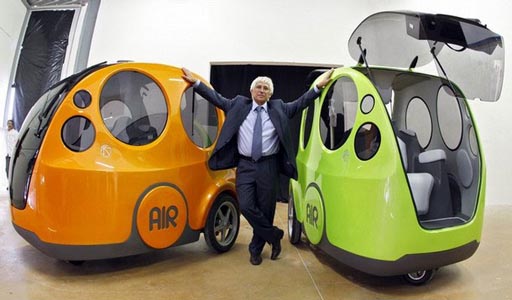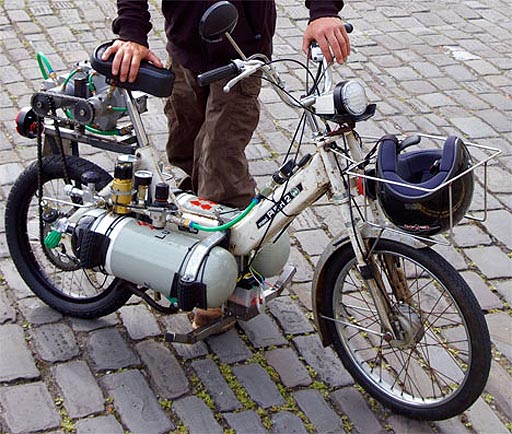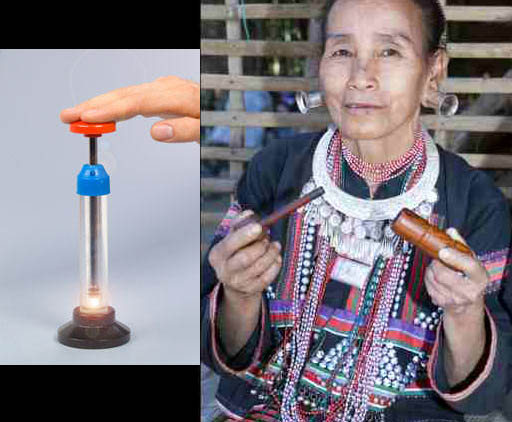For all editions read the sections labeled:
Gas Stoichiometry
Dalton's Laws of Partial Pressures
The Kinetic Molecular Theory of Gases
(You can skip the derivation of PV=nRT)
Real Gases


Air is a mixture of 20% oxygen and 80% nitrogen, with molar masses of 32 g/mole O2 and 28g/mole N2. If we take 80% of 28g/mole and add 20% of 32g/mole, we get 28.8g/mole. So together they act like a gas that is 28.8 g/mole. So if we find the number of moles in a 16 liter tank, we can turn that into grams.
We begin with PV=nRT, and we solve for moles(n). Divide both sides by RT and we get:
PV/RT=n. That can also be written as PV/R/T=n
Remember because our constant (R) has units of atm·Liter/mole·K, we need the psi converted to atm and the 77°F turned into Kelvin.
A |
B |
C |
D |
E |
F |
G |
H |
I |
J |
K |
L |
M |
N |
O |
P |
Q |
R |
S |
T |
U |
V |
W |
|
| 1 | P |
V |
/R |
/K (After dividing by K answer is moles)=n |
moles > g |
wt. of air | add wt of tank |
Final wt. |
|||||||||||||||
| 2 | 3000 |
psi | 1 |
atm | 16.0 | Liter | mole·K | 28.8 |
g | = |
??? | g | + | 10.0 | lb | 454 |
g | = | ??? | g | |||
| 3 | ??? |
psi | 0.0821 | atm·L | =(77-32)*5/9+273 |
K | mol | 1 |
lb | ||||||||||||||
| 4 | This converts °F to K |
||||||||||||||||||||||
Problem 2: What is the number that goes into C3?
Problem 3: What is the weight of air in the 16 liter tank (N2)?
Problem 4: What is the formula that goes into N2?
Problem 5: If you wanted to figure the total weight of the tank at 3500 psi, what cell do you change?
Problem 6: If the temperature was 92°F instead of 77°F, what would the new formula in I3 become?

Problem 7: What cells need to be updated to do that?

The fire piston was invented by people in the southeast asia and Indonesia over a thousand years ago. The principle is that compression of gas will cause the gas to heat up. The same principle is used in diesel engines to ignite the fuel. If done quickly, the heat doesn't have time to be lost and is retained in the cylinder.
My colleagues and I debated about how this compression actually makes the air hotter. I used a spreadsheet to calculate the speed one molecule would speed up if bouncing back and forth from the top to bottom of the cylinder as a piston came down. Each time the molecule hit the moving piston it bounced back a little faster. By the time the piston moved to about 1 cm from the bottom, that molecule had bounced off the moving piston many times making the molecule move at speeds equivalent to temperatures over a 1000°F.
P1V1/T1=P2V2/T2
We know all of these values except for P2 (final pressure). So lets solve for P2 by dividing both sides by V2 and multiplying both sides by T2. We now get
P1V1T2/(T1V2)=P2, which can also be written as P1x V1x T2 /T1 /V2=P2. This looks like a good job for a spreadsheet. Since there's no R in the formula, we don't need pressure measured in atmospheres or volume in liters, but we do have to use Kelvin. So 273 gets added to the Celsius degrees. The units in red cancel out.
A |
B |
C |
D |
E |
F |
G |
H |
I |
J |
K |
L |
M |
|
| 1 | P1 |
V1 |
T2 |
/T1 |
/V2 |
= |
P2 |
||||||
| 2 | 740 |
mm Hg | 10.0 |
mL | =600.+273 |
K | = |
??? |
mm Hg | ||||
| 3 | =25+273 |
K | 1.0 |
mL | |||||||||
Problem 8: What is the final pressure in mm of mercury (mm of Hg)?
Problem 9: What is the formula that goes in L2?
Problem 10: What would be the final pressure if the end volume was 0.7mL?

The pressure in the fire piston will go up at the point the tender attached to the bottom of the pistion catches fire. (I used a piece from a cotton ball in my fire piston). When the cotton burns, it will consume the oxygen but will produce carbon dioxide and water vapor and higher temperatures. So the pressure should go up due to more gases and higher temperature.
Cotton is cellulose, which has the formula of
(C6H12O5)n. The "n" means it is a long chain of these glucose molecules. But we can treat it like it was burning C6H12O5. Here's the balanced equation.
2C6H12O5+13O2 --> 12CO2 + 12H2O
We can't ignore the nitrogen gas, which is 5 times the number of oxygen molecules (5 x 13=65). So we can add that to the reaction.
2C6H12O5 +13O2 + 65N2--> 12CO2 + 12H2O + 65N2
Looking at this we see that we start with 78 moles (12+65) of gases and end with 84 moles (12+12+65) of gases. Also, the burning will increase the temperature. The yellow flame indicates a temperature around 3,000 Kelvin.
This problem is similar to the last one but the intitial conditions are the final conditions in the above problem.
That was P2V2=n2RT2
After the flame heats up the air and creates the extra gases, the condition is different. Let's use P3V3=n3RT3 for the new final condition.
Like before we can solve for R on both and set them equal to each other. This looks like the last time we did it:
P2V2/n2T2=P3V3/n3T3
This time the moles are changing, but the volume is the same. So we need to keep the moles (n2 and n3) but we can drop the volumes. That simplifies it to:
P2/n2T2=P3/n3T3
Solving for the final pressure (P3) by multiplying both sides by n3 and T3 gives us:
P2n3T3/n2T2 = P3
Even though we don't know the exact number of moles, we do know the ratio of moles, which works fine when you have one divided by the other. So the 78 moles for n2 and the 85 moles for n3 that we got from the balanced equation works fine.
A |
B |
C |
D |
E |
F |
G |
H |
I |
J |
K |
L |
M |
|
| 1 | P2 |
n3 |
T3 |
/n2 |
/T2 |
= |
P3 |
||||||
| 2 | Answer from cell L2 from Problem 8 |
mm Hg | 85 |
moles | 3000 |
K | = |
??? |
mm Hg | ||||
| 3 | 78 |
moles | =600+273 |
K | Final Pressure |
||||||||
We can check the units to see if they cancel and we can check the logic. In the above spreadsheet we see that we have 85 moles over 78 moles. So that's 85/78, which will make the pressure larger as expected. We see the temperature ratio of 3000 over 873 or 3000/873, which will also make the pressure larger. So these fractions are doing what we expect should happen to the pressure which is to become larger when there's more moles and higher temperatures.
Problem 11: What is the pressure now after some of the cotton burns (L2)?
Problem 12: What is the pressure of L2 in atmospheres?

A |
B |
C |
D |
E |
F |
G |
H |
I |
J |
K |
L |
M |
|
| 1 | Volume of flattened sphere |
convert cubic feet>Liters |
convert liters>moles |
moles>grams |
g>lb |
wt of air |
|||||||
| 2 | =4/3*3.1416*10*10*2.5 |
cubic feet | 28.317 |
liters | 1 |
mole | 28.8 |
grams | 1 |
lb | = |
??? |
lb |
| 3 | 1 |
cubic ft. | 22.4 |
liter | 1 |
mole | 454 |
g | |||||
| 4 | wt of helium |
||||||||||||
| 5 | =4/3*3.1416*10*10*2.5 |
cubic feet | 28.317 |
liters | 1 |
mole | 4.00 |
g | 1 |
lb | = |
??? |
lb |
| 6 | 1 |
cubic ft. | 22.4 |
liter | 1 |
mole | 454 |
g | |||||
| 7 | Subtract L5 from L2 to get pounds of lift |
=L2-L5 |
lb | ||||||||||
At this point you will have the pounds of lift that the balloon is capable of; however, you would have to estimated the weight of the balloon fabric and the bottom instrument box in order to know what the actual lifting capability of the balloon.
Problem 13: Was this balloon capable of carrying that 50lb boy?